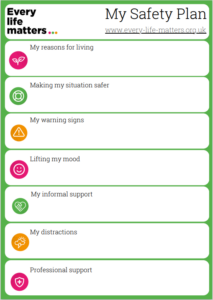Many people will have thoughts of suicide - but thinking about suicide does not make it inevitable that you are going to take your own life. A safety plan helps prevent us turning these thoughts into actions.

A Safety Plan focusses on keeping you safe right now
A Safety Plan includes what you would do, and who might support you, in a crisis. They might include distraction techniques to help you get through the next seconds or minutes as thoughts of suicide becoming overwhelming, how you can make your immediate environment or situation safer, who you can contact when things get really tough, and what you can do in an emergency.
Safety Plans take a stepped approach. They can help us manage those fleeting thoughts of suicide that emerge at the edge of your mind – through to situations where the desire to die becomes so overwhelming we no longer think we can keep yourself safe.
![]()
Make your Safety Plan before you reach crisis point. Being prepared is key. Start writing it now. Its also OK if you feel you can’t complete all of it right now, fill in what you can and come back to the other sections later.
Ask someone to help you write your plan. Find someone else who can support you through it, and bounce ideas off – like a family member, friend or mental health worker. If you name someone in your plan, tell them, and if you can share your safety plan with them.
A safety plan needs to belong to you. It is a very individual plan. Someone can help you develop it but ultimately you need to decide what goes into it, and what works for you.
A safety plan is a practical tool to help you keep safe. It focuses on managing thoughts of suicide and it is not a wellbeing plan or a long term plan to deal with low mood. But do think about what support you might need to make changes in the long run to protect you from thoughts of suicide.
It needs to be a plan that is going to work for you. Make sure you have access to your plan when you need. Have a copy on your phone and if you can, share it with relevant family, friends and professionals such as your GP or mental health worker. Review your plan every so often to check its still relevant.
Write your Plan
You can download a copy of our Safety Plan template here as a PDF.
You don’t have to use these and may prefer to find a more personalised way of constructing your own.
Part 1
Reasons for Living
It is important to remember that as well as having reasons for dying there are also reasons for living. Have these in your plan as a reminder of your reasons to stay alive – they be written down, or photos, or objects. They may be people or animals, commitments or future plans or the hope that things may change.
They may also be thoughts or beliefs relating to
Yourself: Such as – I care enough about myself to live – I have the courage to face life – No matter how bad I’m feeling I know it will not last – I’m afraid of the unknown – I’m afraid of actually killing myself
Family and Friends: Such as – I don’t want my family to feel guilty or to suffer – I have a responsibility or commitment to my family or friends – I love them and if I left them they may question whether I did love them
Beliefs and Hopes: Such as – I believe that I can find a purpose in life – I’m curious what may happening the future – Life is all we have – its better than nothing – Although life feels really tough, things may improve.
Some people make hopeboxes either virtual ones or actual ones with reminders of people and places that are important etc as well as things to sooth and distract
Part 2
Making your situation safer
Do you have a plan of how you would take your own life? Do you know what you would use?
Consider making it harder for yourself to get hold of them, especially when you are feeling in crisis. Can you remove these means from your house? Or give them to a friend or family member to keep.
If you have prescription medication can you can ask that you receive your prescription in smaller amounts? Or ask a friend or family member to hold on to them and allow you a weeks supply at a time?
If you don’t have a plan it is still important to look at how to keep yourself safe.
![]()
- Be aware that alcohol and drugs may make you act more impulsively, or limit your self-control, so it is important to limit consumption.
- Some people and some places may lower our mood when we are feeling vulnerable, or trigger thoughts of suicide. Be aware of them and avoid them if you can.
- If you have previously attempted to take your own life before think about what made it harder to stay safe then. Learn from the experience.
Part 3
Recognising the warning signs
How do you know you’re not feeling safe?
- What thoughts and feelings happen before you start to have thoughts of suicide? Especially around hopelessness or feeling trapped?
- Are your thoughts of suicide increasing in intensity or frequency?
- Are there changes in your behaviour? Perhaps drinking more, isolating yourself, increased self-harm, recklessness or other negative coping habits?
- Could other people close to you recognise these signs and help you become aware of them?
Do you know what may trigger these feelings?
- This may be certain events or times of year, such as an anniversary, or during winter.
- It might be about what’s happening in your relationships or a life event that has left you feeling out of control or feeling helpless.
Part 4
Identify what may lift mood
The first stage of managing those emerging thoughts of suicide is knowing how to lift our mood and distract ourselves. This might include:
- Physical – go out for a run or a walk, head to the gym
- Creative – draw, colour, make a playlist, bake
- Productive – make lists, have a clear out, garden, write yourself a letter
- Chilling out – meditation, have a bath, listen to music, spend time with a pet, game, watch your favourite movie (on repeat if necessary)
- People and places – can you go out and catch up with a friend, play football with mates, go to a museum, go to a faith centre.
Think about what works for you, be realistic, and remember different things might help at different times.
![]()
We probably know some people who are great at distracting us but we wouldn’t necessarily want to speak to them about how we are feeling – get them on this part of your plan. Also be aware of people or places who don’t help our mood, or we need to avoid.
Ideally we want to have a few different options at this point for different times/circumstances. We don’t want to have our only option as running if you are a fair weather runner and we live in Cumbria!
If this is the first time you are feeling like this and you are not sure what may work – don’t worry – look at some of the options above and think would any of these work for me, what do you feel might and give it a go.
Remember its not a ‘one size fits all’ what works for one person may not work for another – but sometimes it maybe worth giving things a go.
Part 5
Identify your informal support
If your chosen distractions are struggling to lift your mood, and thoughts of suicide are still present, or growing, reach out to informal support.
These are the safe and trusted people, or organisations, that you feel comfortable to talk about how you are feeling – including talking about your thoughts of suicide.
Get at least three of these on your Safety Plan. They could include;
- Friends, family or colleagues.
- A key worker or volunteer at an organisation that supports you.
- A local or national telephone or text Helpline such as the Samaritans or CALM
- An online support forum
- Have a look at our Getting Help page for more information about where to get support
![]()
Have at least three named people/helplines on your plan. Make sure to include contact details on your plan and put their numbers in your phone for when you really need them.
If you put friends, family or colleagues in your plan tell them. And if you feel comfortable share your Safety Plan with them. You can also share other information with them from this website about supporting someone with thoughts of suicide.
Think about having a “cue” word or action between you. Sometimes it can feel really hard to start the conversation. Having a “cue” word or action can mean that the person named on your plan can help you start the conversation.
If you are not able to identify any friends or family to include at this stage – that is ok. There is lots of help out there. Have a look at our Getting Help pages. There are lots of helplines listed there with trained staff who are there to listen confidentially to whatever you need to talk about, and in your own time.
Part 6
Distractions
If the thoughts of suicide are getting stronger – and we are not able to lift our mood or talk to anyone, or talking hasn’t helped – we need to take further proactive steps to keep ourselves safe.
You may be overwhelmed – but it is so important to remember these feelings will pass.
Studies suggest that thoughts of suicide are strongest for 15-30 minutes. You need to focus on how you will get through this period of time.
Step by step. Minute by minute. Stay safe for now and not act on the urges. .
This is where your Safety Plan is so important. You need distractions and activities to get you through one minute at a time. People have used some or all of the following – find what works for you.
- It could be some of the distractions listed in Part 4
- Breathing exercises
- Games on your phone
- Distracting self so the urge passes.
- Positive statements that you use to inspire you or a faith
- Your Reasons for Living or Hopebox
Have a look at Papyrus’s Coping Strategies and Distraction Techniques for more ideas.
Part 7
Getting professional support
If you are in crisis or no longer feel able to manage the thoughts of suicide then identify in your Safety Plan how you will get professional help.
- Are you connected with any mental health professionals? Do you have a Care Co-ordinator for example? If you are, do you know how to get hold of them in a crisis? Get their contact details in your plan and in your phone.
If its your first time in crisis
- Call the 24hr Universal Mental Health Crisis Lines – North Cumbria 0800 652 2865 – South Cumbria 0800 953 0110
- Contact your GP for an emergency appointment.
- Call NHS 111, they can direct you on how best to get help or how to access out of hours’ doctors.
Again get these contact details in your plan.
Remember when you go to see your GP its OK to take a family member or friend with you for support. Be open about your thoughts and feelings, including suicide, and bring a copy of your Safety Plan with you.
![]()
Are you in immediate danger of taking your own life? Have you already harmed yourself or taken an overdose? Do you have imminent plans for killing yourself? Are your thoughts of suicide particularly intense right now and do you feel unable to stay safe?
If so, seek immediate help now
- Call 999 – The call is free. Explain what is happening to you. You can stay on the line while you wait for help to arrive.
- Or go to a Hospital A&E – Find your nearest here.
- If you have someone else around ask them to call 999 for you and stay with you wait for the ambulance, or take you to A&E immediately.
Getting Help
If you are really struggling to cope, or feel overwhelmed by difficult feelings or thoughts of suicide, then reach out for professional help. It’s OK to ask for more support to see you through this difficult time.
Find out more about Getting Help to support your mental health and wellbeing.
Thinking about suicide?
When life gets out of control it’s not unusual to feel really overwhelmed -...
read moreWorried about someone?
Are you concerned someone you know is having thoughts of suicide? Many, many people...
read moreBereaved by suicide?
Suicide bereavement is a unique loss. It has been described as one of the...
read moreSafety Planning
A Safety Plan includes what you would do, and who might support you, in...
read moreSelf-harm
Our Self-harm Safe Kits are a resource for anyone wanting to understand, and begin to...
read moreSupport Directory
Browse our directory for more information about the Support and Services available to you...
read more
